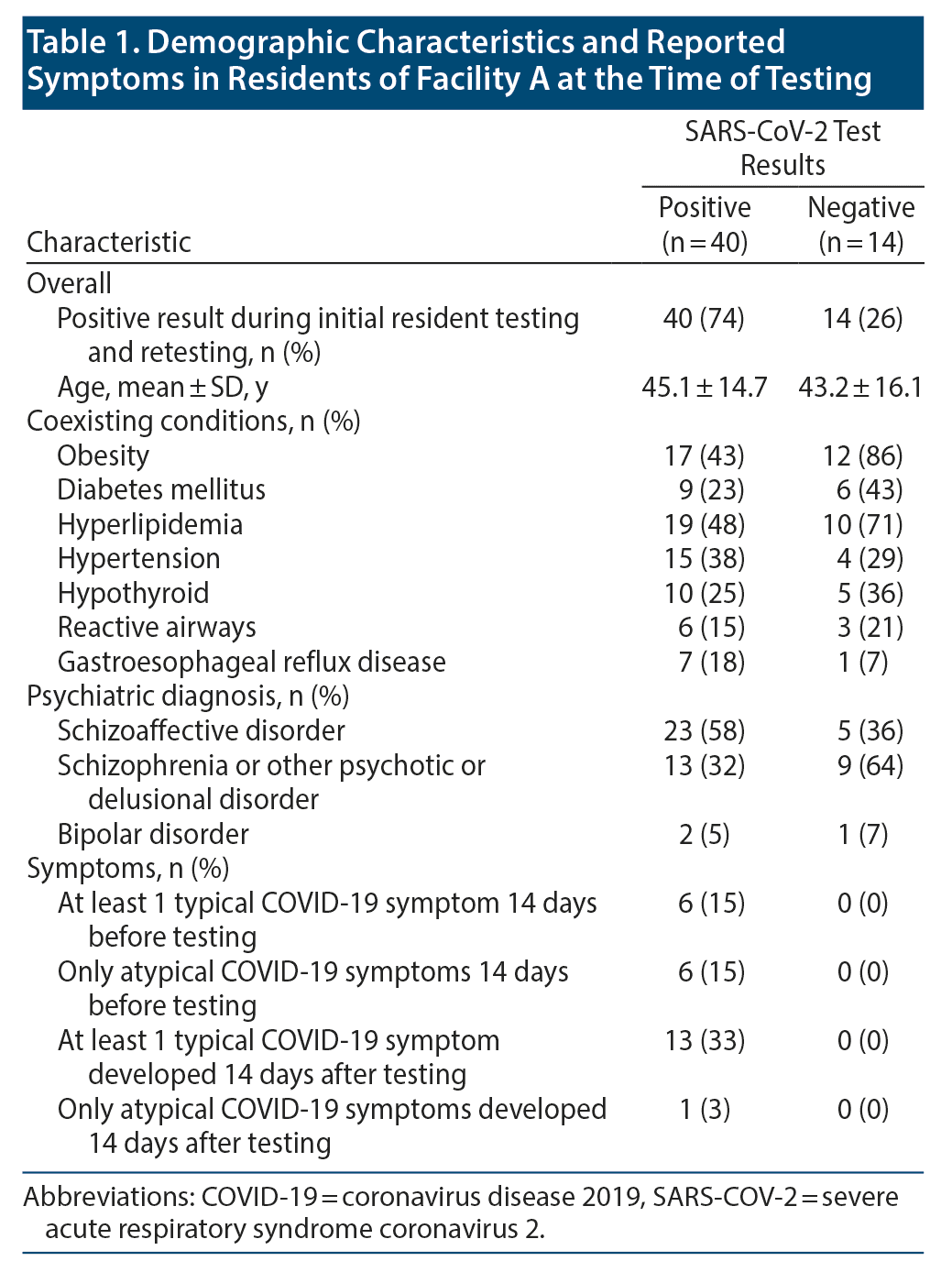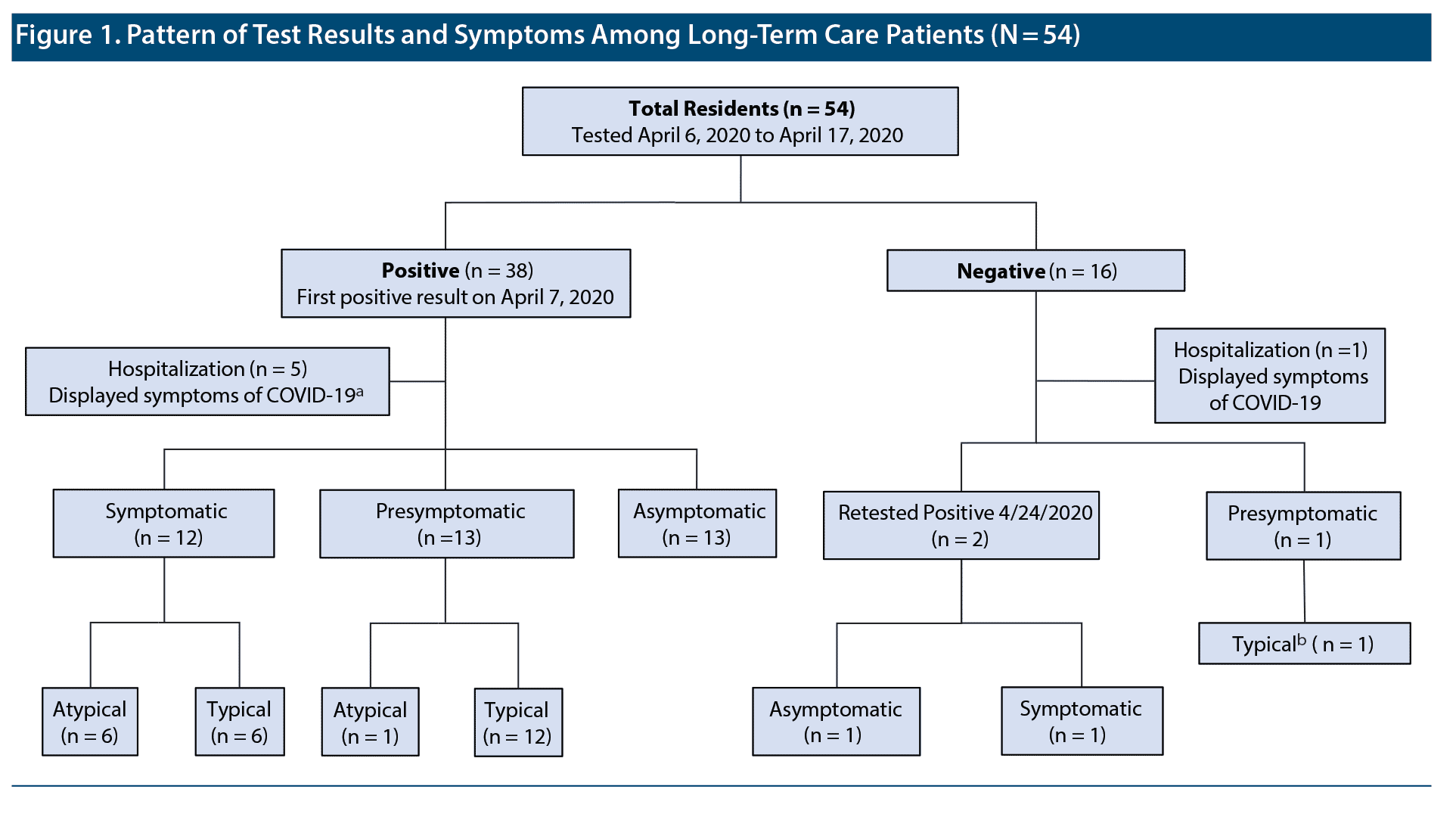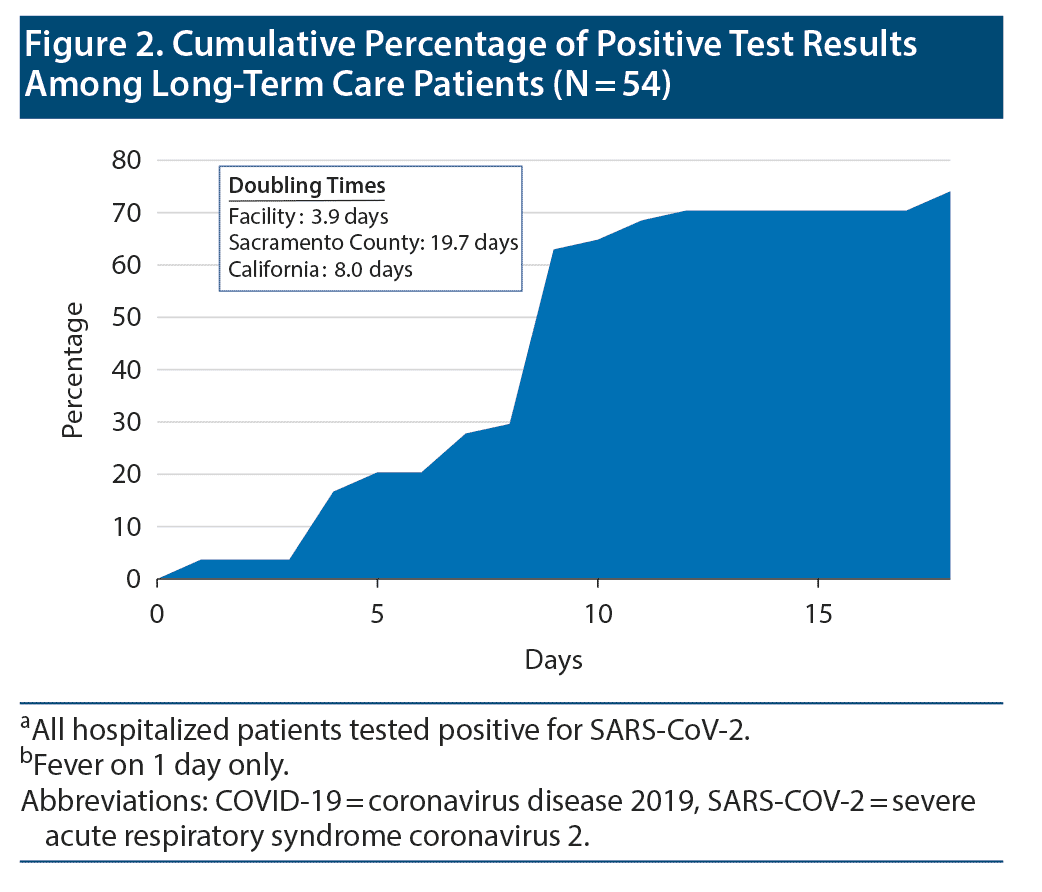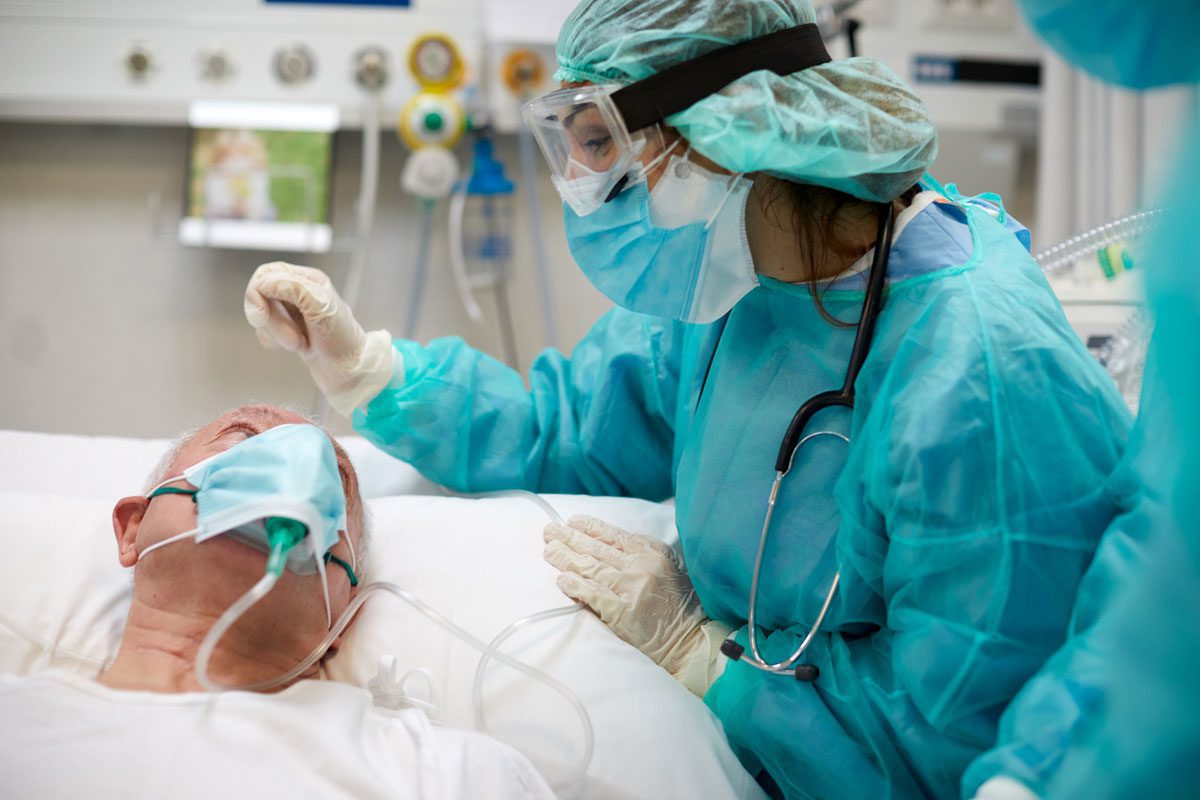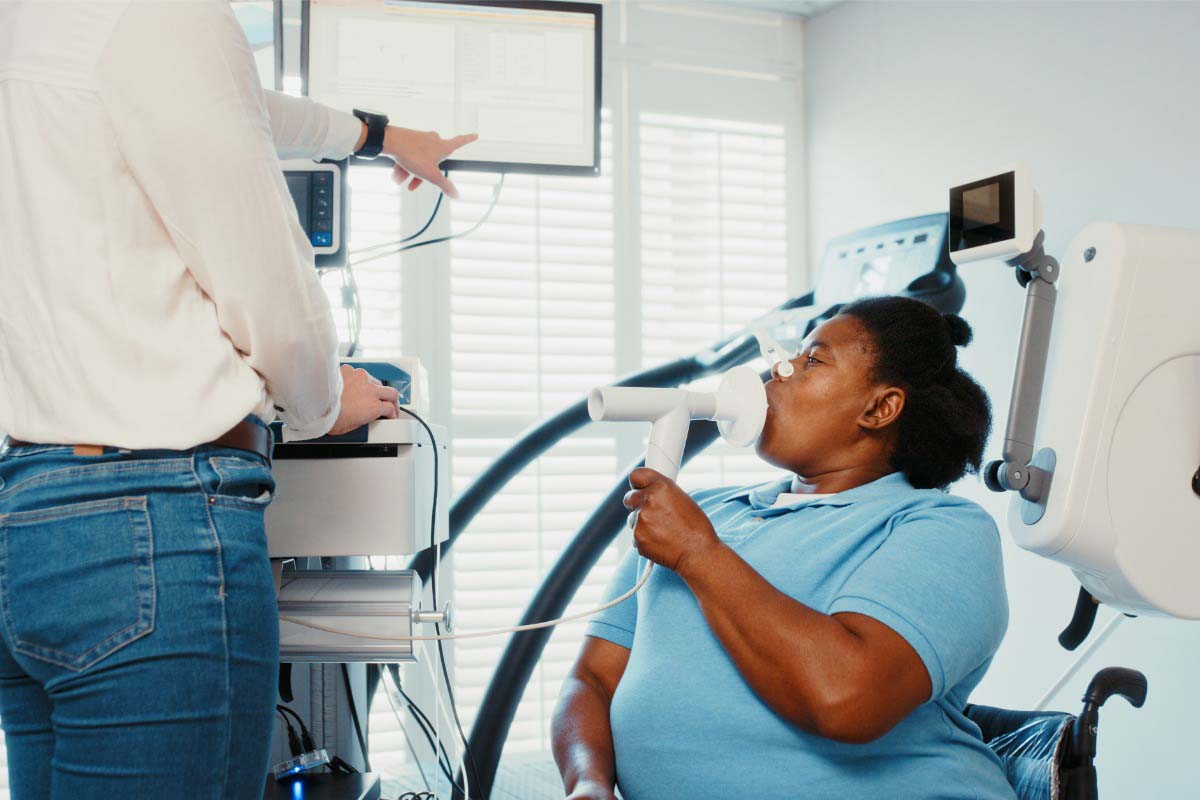Objective: To report the clinical characteristics and transmission rate of coronavirus disease 2019 (COVID-19) in a community inpatient long-term care psychiatric rehabilitation facility designed for persons with serious mental illness to provide insight into transmission and symptom patterns and emerging testing protocols, as well as medical complications and prognosis.
Methods: This study examined a cohort of 54 residents of a long-term care psychiatric rehabilitation program from March to April 2020. Baseline demographics, clinical diagnoses, and vital signs were examined to look for statistical differences between positive versus negative severe acute respiratory syndrome coronavirus 2 (SARS-COV-2) groups. During the early phase of the pandemic, the facility closely followed the local shelter-in-place order (starting March 19, 2020) and symptom-based testing.
Results: Of the residents, the primary psychiatric diagnoses were schizoaffective disorder: 28 (51.9%), schizophrenia: 21 (38.9%), bipolar I disorder: 3 (5.5%), and unspecified psychotic disorder: 2 (3.7%). Forty (74%) of 54 residents tested positive for SARS-COV-2, with a doubling time of 3.9 days. There were no statistical differences between the positive SARS-COV-2 versus negative groups for age or race/ethnicity. Psychiatric and medical conditions were not significantly associated with contracting SARS-COV-2, with the exception of obesity (n = 17 [43%] positive vs n = 12 [86%] negative, P = .01). Medical monitoring of vital signs and symptoms did not lead to earlier detection. All of the residents completely recovered, with the last resident no longer showing any symptoms 24 days from the index case.
Conclusion: Research is needed to determine optimal strategies for long-term care mental health settings that incorporate frequent testing and personal protective equipment use to prevent rapid transmission of SARS-COV-2.

COVID-19 Transmission in a Psychiatric Long-Term Care Rehabilitation Facility:
An Observational Study
ABSTRACT
Objective: To report the clinical characteristics and transmission rate of coronavirus disease 2019 (COVID-19) in a community inpatient long-term care psychiatric rehabilitation facility designed for persons with serious mental illness to provide insight into transmission and symptom patterns and emerging testing protocols, as well as medical complications and prognosis.
Methods: This study examined a cohort of 54 residents of a long-term care psychiatric rehabilitation program from March to April 2020. Baseline demographics, clinical diagnoses, and vital signs were examined to look for statistical differences between positive versus negative severe acute respiratory syndrome coronavirus 2 (SARS-COV-2) groups. During the early phase of the pandemic, the facility closely followed the local shelter-in-place order (starting March 19, 2020) and symptom-based testing.
Results: Of the residents, the primary psychiatric diagnoses were schizoaffective disorder: 28 (51.9%), schizophrenia: 21 (38.9%), bipolar I disorder: 3 (5.5%), and unspecified psychotic disorder: 2 (3.7%). Forty (74%) of 54 residents tested positive for SARS-COV-2, with a doubling time of 3.9 days. There were no statistical differences between the positive SARS-COV-2 versus negative groups for age or race/ethnicity. Psychiatric and medical conditions were not significantly associated with contracting SARS-COV-2, with the exception of obesity (n = 17 [43%] positive vs n = 12 [86%] negative, P = .01). Medical monitoring of vital signs and symptoms did not lead to earlier detection. All of the residents completely recovered, with the last resident no longer showing any symptoms 24 days from the index case.
Conclusion: Research is needed to determine optimal strategies for long-term care mental health settings that incorporate frequent testing and personal protective equipment use to prevent rapid transmission of SARS-COV-2.
Prim Care Companion CNS Disord 2020;22(6):20m02765
To cite: Xiong GL, Atkin A, Moquin K, et al. COVID-19 transmission in a psychiatric long-term care rehabilitation facility: an observational study. Prim Care Companion CNS Disord. 2020;22(6):20m02765.
To share: https://doi.org/10.4088/PCC.20m02765
© Copyright 2020 Physicians Postgraduate Press, Inc.
aDepartment of Psychiatry and Behavioral Sciences, University of California Davis Medical Center, Sacramento, California
bSacramento County Behavioral Health Services, Sacramento, California
cSacramento Crestwood Behavioral Health, Sacramento, California
dSacramento County Health and Human Services, Sacramento, California
eSacramento County Department of Public Health, Sacramento, California
fCalifornia Association of Long Term Care Medicine, Santa Clarita, California
gMental Health Service, VA Northern California Health Care System, Mather, California
*Corresponding author: Glen L. Xiong, MD, CMD, University of California Davis Medical Center, 2230 Stockton Blvd, Sacramento, CA ([email protected]).
The coronavirus disease 2019 (COVID-19) pandemic has affected many communities in the United States, and long-term care health settings are at very high risk of transmission due to close living quarters. The first case of community transmission in Sacramento, California was reported on February 27, 2020.1 Presymptomatic transmission in a long-term care skilled nursing facility was first described in May 2020.2 Since that time, Thompson et al3 described transmission patterns in a state psychiatric hospital in Louisiana. Psychiatric long-term care facilities are similar to state psychiatric hospitals but are regulated like skilled nursing facilities. However, psychiatric long-term care facilities tend to have younger patients compared to traditional skilled nursing facilities, and the patients tend to have chronic mental illness and are often more ambulatory and able to perform activities of daily living. During this time period, many providers worked from home to avoid exposure due to health risk factors. Generally speaking, telehealth options are not always feasible for inpatient mental health and nursing professionals.
We report the clinical characteristics and transmission rate in a community inpatient long-term care psychiatric rehabilitation facility especially designed for persons with serious mental illness. We aim to elucidate the clinical course of COVID-19 spread, symptoms, and medical and psychiatric characteristics to provide insight into transmission and symptom patterns and emerging testing protocols, as well as medical complications and prognosis.
METHODS
Study Site and Design
The community program is a 54-bed locked, long-term psychiatric rehabilitation facility located in Sacramento, California. We received a research waiver from the University of California at Davis (UC Davis) Institutional Review Board. Psychiatrists and primary care providers typically see patients once per month. Patients participate in group activities including vocational rehabilitation, recreation, and therapy. There are daily outings for most residents who are not on restrictions (eg, safety watch, elopement risks). Group activities, outings, and visitation were placed on hold on March 19, 2020 when the shelter-in-place order was issued by the county public health department. The mean and median lengths of stay of patients in the facility are 3.0 and 1.6 years, respectively. Of the 54 residents, 28 (51.9%) had schizoaffective disorder, 21 (38.9%) had schizophrenia, 3 (5.5%) had bipolar I disorder, and 2 (3.7%) had unspecified psychotic disorder. This was an observational longitudinal descriptive study of system responses to identify, monitor, and manage severe acute respiratory syndrome coronavirus 2 (SARS-COV-2) patients in a long-term care mental health rehabilitation facility.
Procedures and Measures
In early March 2020, as part of the quality assurance program, we developed a method for searching for keywords in the nursing notes of the electronic health record by using Open Database Connectivity via Microsoft Access database. The queries allowed us to review those residents for possible potential development of SARS-COV-2 symptoms. Words searched were cough, dyspnea, diarrhea, fever, headache, respiratory, SOB, and shortness of breath.
Sensitivity analysis was performed on vital signs that were recorded in the electronic health record to determine if there were changes in blood pressure and pulse that may be indicative of viral illness. We compared the percentage change of the average blood pressure (diastolic/systolic) and pulse (from February 2020 values) against 6 different datasets for 7 days before 7 days after test day, 7 days before day of test and day of test, 5 days before day of test and 5 days after, 2 days before day of test and 7 days after, day of test and 7 days after, and day of test and 14 days after.

- Coronavirus disease 2019 (COVID-19) infection has rapid transmission in psychiatry long-term care settings despite following shelter-in-place orders and symptom-based testing.
- A high and rapid transmission rate of COVID-19 infection can occur in long-term care mental health settings.
- Research is needed to determine optimal strategies for long-term care mental health settings that incorporate frequent testing and personal protective equipment use to prevent rapid transmission of COVID-19.
Symptom-based testing was performed following US Centers for Disease Control guidelines at the time. Laboratory testing supplies for SARS-COV-2 were completed at UC Davis and Sacramento County laboratories using the CDC Assay Applied Biosystems StepOnePlus (Applied Biosystems, Foster City, California) and Cobas 6800 System (Roche, Basel, Switzerland).
Data Analysis
We examined baseline demographics, clinical diagnoses, and vital signs to look for statistical differences between positive versus negative SARS-COV-2 groups. The doubling time of viral spread within the facility was calculated using least squares regression of the log-transformed daily cumulative counts of residents positive for SARS-COV-2, from the first positive test occurrence (April 6, 2020) through the last date of occurrence (April 24, 2020). Doubling time was estimated as the natural log(2) divided by the daily growth rate.2
RESULTS
There were no statistical differences among the positive SARS-COV-2 versus negative groups for age and race/ethnicity: mean ± SD of 45.1 ± 14.7 years for positive versus 43.2 ± 16.1 years for negative (P = .70). Of the 40 residents who tested positive for SARS-COV-2, 21 (52.5%) were white, 7 (17.5%) black, 5 (12.5%) Asian, 4 (10.0%) Hispanic, and 3 (7.5%) "other." Of the 14 residents who tested negative, 7 (50.0%) were white, 4 (28.6%) black, 2 (14.3%) Asian, and 1 (7.1%) Hispanic (Table 1).
With the exception of obesity, there were no significant clinical differences between residents who tested positive versus negative for SARS-COV-2 for the following variables: obesity (n = 17 [43%] vs n = 12 [86%], P = .01), hyperlipidemia (n = 19 [48%] vs n = 10 [71%], P = .12), hypertension (n = 15 [38%] vs n = 4 [29%], P = .55), hypothyroidism (n = 10 [25%] vs n = 5 [36%], P = .44), diabetes (n = 9 [23%] vs n = 6 [43%], P = .14), gastroesophageal reflux disorder (n = 7 [18%] vs n = 1 [7%], P = .35), and smoker (n = 29 [54%] vs 11 [20%], P = .56) (Table 1).
Symptomatic, presymptomatic, and asymptomatic status is described in the flowchart of symptom development (Figure 1), since the index diagnosis of the first patient who developed shortness of breath and lethargy was sent to the academic medical center for evaluation and tested positive for SARS-COV-2. A total of 6 residents required hospitalization for a mean duration of 11.5 days. One resident who initially tested negative on April 10, 2020 later developed fever and retested positive on April 23, 2020.
The pattern of increasing cases of COVID-19 at the facility shows a doubling time among residents of 3.9 days (Figure 2) compared to 19.7 days in the Sacramento County area at the same time period.4
Analysis of vital signs showed no differences between positive versus negative SARS-COV-2 residents. All of the residents completely recovered, with the last resident no longer showing any evidence of COVID-19 infection on April 30, 2020, which was 24 days from the index case.
DISCUSSION
There was rapid spread of SARS-COV-2 in this long-term mental health rehabilitation facility despite adherence to county, state, and federal policies and procedures. Proactive screening by symptom reporting and adherence to symptoms-based testing did not help with early detection. Similar rapid and widespread transmission of SARS-COV-2 has been demonstrated in US skilled nursing facilities—the first, second, and third cases were reported in King County, Washington State, and Wyoming, respectively.2,5-7 The full extent of spread was not realized until universal screening and monitoring were implemented. Federal, state, county, and institutional leadership is needed to support clinical, laboratory, human resource, and other administrative operations to ensure the health of patients, the well-being of providers, and the health of communities.8 The residents showed full recovery within 4 weeks. Nevertheless, continued monitoring and research are needed to examine psychological symptoms and other health-related problems.7 Finally, more systematic research is need to determine optimal testing strategies that most likely need to be coupled with use of personal protective equipment use, as testing is being conducted that is specific to long-term care settings.
Limitations
Limitations to this study include its descriptive narration, single-site analysis, and use of retrospective data. This is a real-word example of a facility following public health policies and local shelter-in-place orders. As this is not an experimental study, there was no validation of how procedures or policies were followed. Also, nursing documentation is subject to recall and information biases.
CONCLUSION
Long-term psychiatric facilities are at high risk for SARS-COV-2 infections. Universal testing is likely to be the most reliable method of detection of SARS-COV-2, as symptom reporting by severely ill patients and medical monitoring (eg, vital signs) appears less helpful. System responses for detection, monitoring, process improvement, and communication appear helpful. Future research should prospectively evaluate testing and management strategies to reduce COVID-19 morbidity and mortality in mental health settings.
Submitted: July 24, 2020; accepted September 22, 2020.
Published online: November 5, 2020.
Potential conflicts of interest: None.
Funding/support: This project was partly supported by the quality improvement program at Sacramento Crestwood Behavioral Health to Dr Blum and Mr Atkin.
Role of the sponsor: The Crestwood facility allotted time for their employees to provide data reporting but had no role in the design or conduct of the study; collection, management, analysis, or interpretation of data; or preparation, review, or approval of the manuscript.
Acknowledgments: This article is dedicated to the many health care heroes who cared for the residents selflessly during the COVID-19 outbreak and the leadership team who provided endless tangible and moral support. We especially want to acknowledge the following individuals and institutions: Adrain Smith, BSW, LNHA; Ililta Zerezghi, RN; Candice Hayashi, RN; Pam Norris, CPRP; Sacramento County Public Health; and University of California Davis Health System. None of the acknowledged individuals report conflicts of interest related to the subject of this article.
REFERENCES
1. CDC Confirms Possible Instance of Community Spread of COVID-19 in US. Centers for Diseases Control and Prevention website. https://www.cdc.gov/media/releases/2020/s0226-Covid-19-spread.html. Published February 26, 2020. Accessed June 27, 2020.
2. Arons MM, Hatfield KM, Reddy SC, et al; Public Health-Seattle and King County and CDC COVID-19 Investigation Team. Presymptomatic SARS-CoV-2 infections and transmission in a skilled nursing facility. N Engl J Med. 2020;382(22):2081-2090. PubMed
3. Thompson JW, Mikolajewski AJ, Kissinger P, et al. An epidemiologic study of COVID-19 patients in a state psychiatric hospital: high penetrance rate despite following initial CDC guideline. Psychiatr Serv. Published online October 6, 2020. PubMed CrossRef
4. Case Data for California COVID-19 Response. California Department of Public Health Coronavirus Science Branch. https://data.ca.gov/dataset/590188d5-8545-4c93-a9a0-e230f0db7290/resource/926fd08f-cc91-4828-af38-bd45de97f8c3/download/statewide_cases.csv. March 18, 2020-Present. Accessed June 21, 2020.
5. McMichael TM, Currie DW, Clark S, et al; Public Health-Seattle and King County, EvergreenHealth, and CDC COVID-19 Investigation Team. Epidemiology of COVID-19 in a long-term care facility in King County, Washington. N Engl J Med. 2020;382(21):2005-2011. PubMed CrossRef
6. Kimball A, Hatfield KM, Arons M, et al; Public Health-Seattle and King County; CDC COVID-19 Investigation Team. Asymptomatic and presymptomatic SARS-CoV-2 infections in residents of a long-term care skilled nursing facility—King County, Washington, March 2020. MMWR Morb Mortal Wkly Rep. 2020;69(13):377-381. PubMed CrossRef
7. Callaghan AW, Chard AN, Arnold P, et al. Screening for SARS-CoV-2 infection within a psychiatric hospital and considerations for limiting transmission within residential psychiatric facilities—Wyoming, 2020. MMWR Morb Mortal Wkly Rep. 2020;69(26):825-829. PubMed CrossRef
8. Metzl JM, Maybank A, De Maio F. Responding to the COVID-19 pandemic: the need for a structurally competent health care system. JAMA. 2020;324(3):231-232. PubMed CrossRef
This PDF is free for all visitors!
